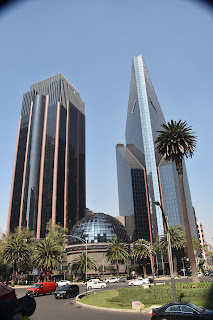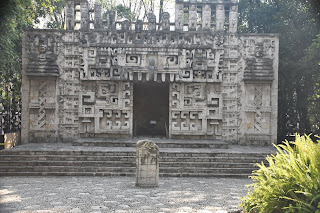
the downtown area is dominated by the national catholic church. altars are gold plated and ornately decorated in the early Spanish tradition. because it was constructed on a lakebed the church is slowly sinking. some restoration work is being attempted but because of the size and age of the building the sinking continues.

the large plaza was the intended location for the church but becasue this was a lakebed area teh ground was too soft to accomodate the building and so it was change to the present place and the original area made into this plaza now called "zocalo" or the base. public celebrations and demonstrations are often seen in this area.
this arrangement reminds me of the church and plaza in Milan Italy.
Mexico City’s Angel of Independence Monument stands as a tribute to the
heroes of the Mexican War of Independence from Spain. From 1521when
Hernán Cortés defeated the Aztec nation, until the early 1800s, the vast
country of Mexico was a colony of Spain, separated by the wide Atlantic
Ocean. under renovation when we were there the wall surrounding the monument was a place for artistic graffiti.
why not build a monument in the middle of a major roadway?
a monument commemorating the Mexican statesman Benito Juárez. The statue of Juárez is flanked by marble Doric columns. There are two allegorical female statues next to Juárez, representing the fatherland and law.
the city has many parks that offer really nice walking areas and places to eat lunch either brought from home or purchased at a street vendor.
Modern buildings contrast with traditional structures along every street.








not all buildings suffer growing old as well as some


the museum of anthropology is exceptionally well done giving us a tour through the ages of development in Mexico. the fountains and main entrance give no clue as to the contents.
the preview show is complete with models that appear on cue and with accompanying story about the ancients who occupied the land well before the christian era.

there is recreation of an Aztec building in the museum.

Teotihuacan pyramids are archiological wonders. recognizing that these structures were built during a period that ranged from the 500BC to around 1200CE and that their use and occupancy was both religious and commercial it is no wonder that the pyramids are the most visited historical site in Mexico. at its peak this city complex had over 125,000 residents and was the sixth largest city in the world around the 1000-1200CE.
looking down the avenue of the dead from the top of the moon temple the avenue appears to be a level single incline leading up through the main town area. in fact there are several plateaus and steps along the way giving a rise of over 300' but the engineering is such to give the appearance of this single incline when viewed from the temple. this coupled with the actual building of the pyramids and the surrounding buildings show clearly that these ancients were very intelligent and creative. and yes, they did have human sacrifices to their various gods.




tourists are allowed to climb to the top of the pyramids and I did that. the steps are steep and oddly spaced making the assent and descent a bit tricky.

Quinceañera the 15th birthday celebration for young girls are often extravangant events here is one with mounted mariachi posing for photos with the birthday party.
adjacent to the national church at Zocalo are the remains of a mesoamerican temple that was partially demolished by the Spanish when introducing christianity to Mexico.
this tree trunk held such revered place for the natives that it was partially preserved.

this model gives an idea of the layout of the original temple. the national church sits toward the left front of this.
several mesoamerican kings and high priests reigned over this temple during its life. with each new high priest the temple was expanded. this model gives a guide to the expansions. i found it interesting that each expansion was built over the preceding. some of the original temple has been located by land radar and remains buried under the national church building.
snakes and eagles were culturally important to the mesoamericans and were included in many structures. this fellow guarded an entrance to the temple major in Mexico City.

Xochimilco is a city near Mexico City that originated with the ancients. the lake that formed in the area was ideal for humans andso the ancients began to build islands on which they lived. these islands created a array of canals that offered security and easy transportation by boat. today this town attracts tourists (like us) as well as locals for various parties, events or just a relaxing afternoon boat ride.
this area is a major flower supplier with many of the growers located on these islands
there are a lot of boats for rent with polers to move you through the jumble of crafts.
You can be serenaded by mariachis or buy food from boat kitchens
Chapultepec Castle is a national monument and museum which previously served as home and office for Maximilian who for a while was the emperor of Mexico. he was ill equipped for this role and would die after only 3 years as emperor. he did leave his castle to the Mexican people for public use insuring that it would a national treasure. it is kept furnished as he lived so that the culture of the time is preserved. several subsequent presidents have used the building as home and office but now it is a museum. the surrounding grounds are a huge park with museums and boating areas.




street vendors are the lifeblood of the city. every day and double on weekends the sidewalks and parks are filed with small vendors selling everything imaginable. visual and nasal senses are filled with exciting views and delicious aromas. weekends offered opportunities to dance in the street and sample unique culinary treats.
street dances
cartoon characters welcomed customers

buy your fish or meat to cook at home or eat on the sidewalk


want to feel like a Lucha Libre wrestler? pick your hero.
Need shoes?


some major roads are closed to traffic on weekends so runners can exercise without fear of being hit.
our 8 days in Mexico City and surrounds were not enough a return will be needed.
the hop on hop off bus system is a great way to check out a city












































No comments:
Post a Comment